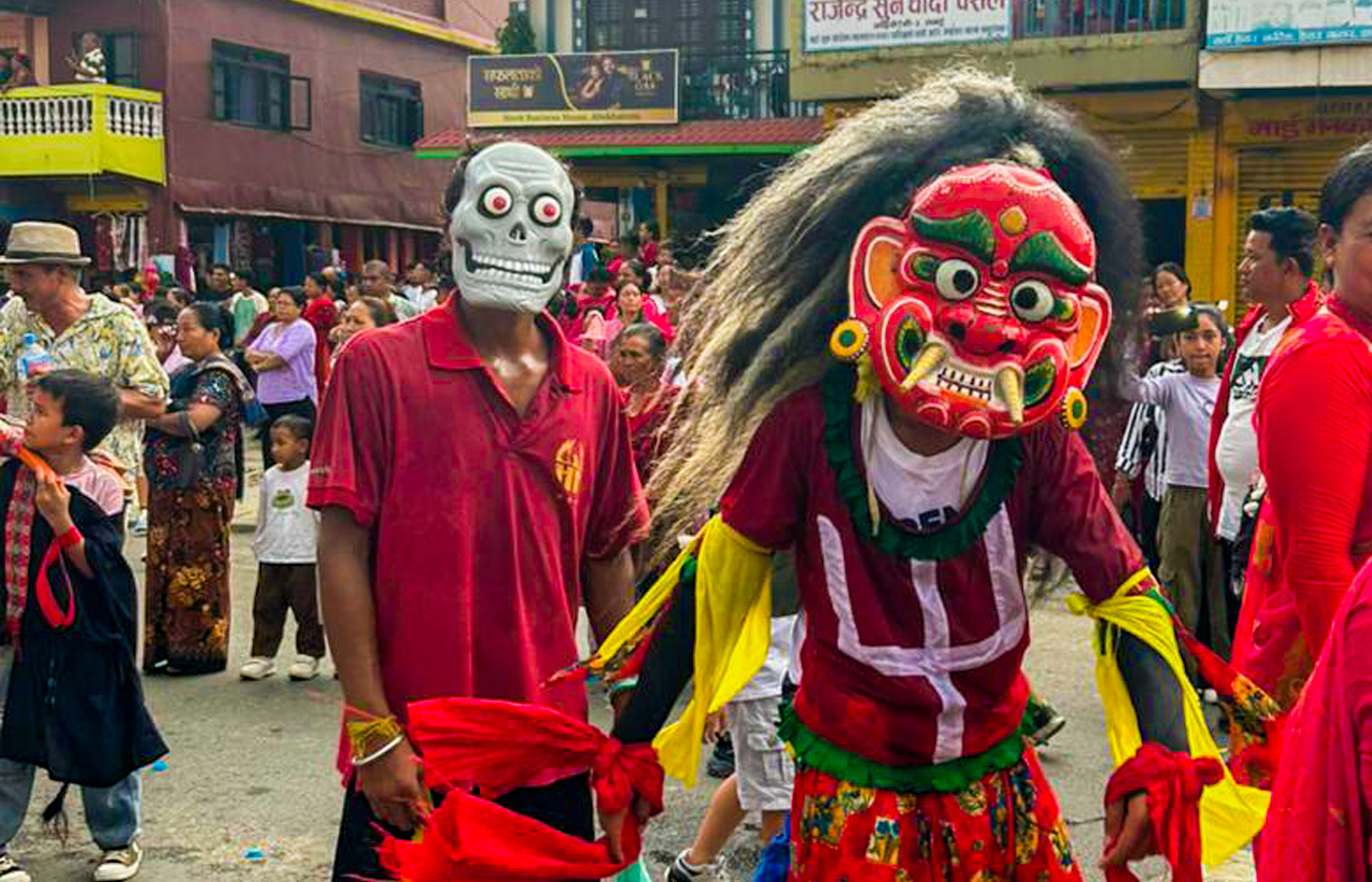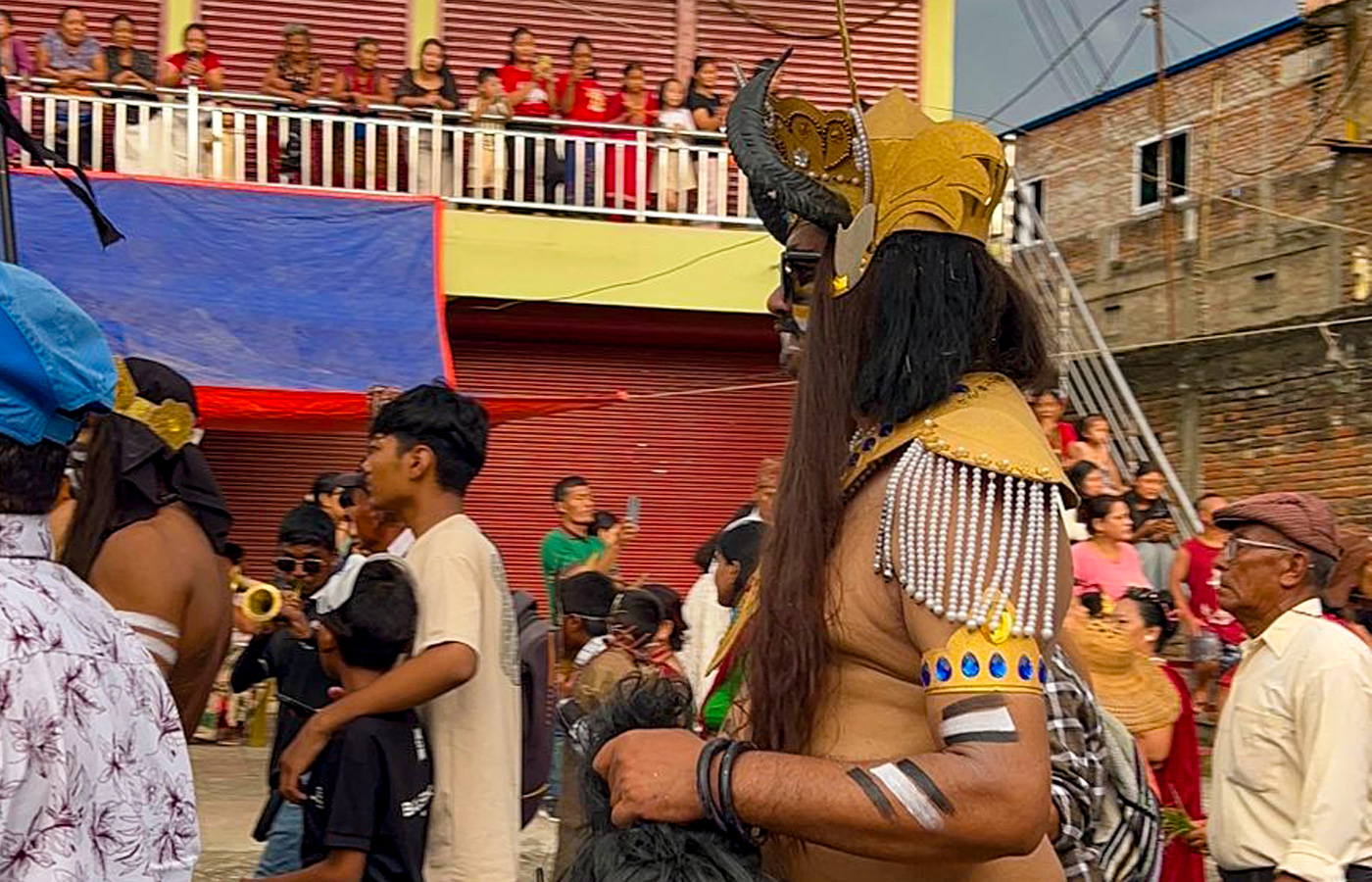Gai Jatra, also known as the ‘’cow festival,’’ or "Festivals of Cow," is one of the promising Hindu festivals of Nepal. This festival commemorates the death of loved ones. It is celebrated in Kathmandu Valley, particularly in the cities of Kathmandu, Bhaktapur, and Patan. Blended with joy and sorrow, this festive holds emotional significance to the Nepalese.
Gai Jatra,” the name reflects the role of the cow in the festival. In Hindu belief, cows are known for guiding the souls of the deceased to the afterlife. During the festival, families who have lost loved ones lead a cow or a child dressed as a cow in a parade through the streets. This act symbolizes an act of a cow guiding the departed soul to a safe afterlife.
Updated Gai Jatra Festival 2025 and 2082 Dates in Nepal according to Nepali Calendar.
Mainly celebrated by the Newar community of Nepal, the festival holds a special place and is highly regarded by all citizens of Nepal. Once again, all the Nepalese are looking forward to the celebration of Gai Jatra on 10th August 2025(as per Nepali date: 2082/04/25, which is Shrawan 25th, Sunday). This year, Gai Jatra, or Cow Festival, is after the day of Jannai Purnima, also known as Nepali Rakshya Bandhan (2082/04/24; Shrawan 24 Saturday).
The backstory of the Gai Jatra Celebration: How Gai Jatra started?

In the 17th century, when King Pratap Malla lost his beloved son, the Queen was deeply saddened. Regardless of the king's best efforts, he was unable to comfort his heartbroken wife. Of his desire to see her smile again, he declared about the cow parade event.
The King suggested that every family with lost members participate in the event. The idea behind this act was to indulge the realization that death is inevitable. However, this event became more than grief, and the participants added humorous elements. Witnessing the collective sorrow and the humor used to cope with the pain, the queen smiled, and the event succeeded.
The accomplishment of this gathering turned out to be more than a one-time thing. With this resilient ambiance of the festive season, King decided to do this annually to sustain the hopes and beliefs of the people. This started the century-old Gai Jatra celebration to be an annual celebration.
Myth Behind Gai Jatra "Cow Festival"
The myth behind Gai Jatra is that King Pratap Malla started the festival to help bereaved families honor their deceased loved ones and console his grieving queen.
Myth details:
- King Pratap Malla ruled Nepal from 1641 to 1674 AD.
- His teenage son, Chakravartendra Malla, died, leaving the queen heartbroken.
- To ease her sorrow and support other grieving families, the king ordered a grand procession.
- Families who had lost a loved one that year were instructed to parade a cow through the streets.
- The cow was believed to help the bereaved find solace and guide the departed souls to the afterlife.
How do people celebrate Gai Jatra in Nepal?
During Gai Jatra time, families from different homes who have lost loved ones in the past year lead a cow through the street. In families without cows, a child is dressed as a cow to play the role of guide for the departed soul. The cow is said to aid the departed relative’s passage to heaven.
This gathering involves street cultural performances with dance and music, parades, and offerings to the beloved ones. Families offer food, flowers, and other sacred items for the loved ones who have passed away. These activities represent a sense of appreciation and spiritual strength of life.
Significance of Gai Jatra Festival: realization about the fact of life
The festival is mainly about the remembrance of loved ones who have passed away. This celebration reflects the prominent traditions, beliefs, and endurance strength of every Nepali. It plays a key part in showcasing the cultural identity of the Newar community.
The humorous sessions associated with the Gai Jatra festival support the grieving, honor the deceased, and celebrate life’s continuity. It reflects the shared support during times of grief between each Nepali.
In 2025, as Gai Jatra enters the streets of Kathmandu Valley again, it will remind every family home to appreciate each other’s presence. Once again, the families will be struck by the realization of life and the afterlife. Sorrows and happiness are shared among each other while healing through hope processes.
Why should you experience Gai Jatra festival in 2082 | 2025?

Gai Jatra is an exceptional festival in Nepal to be part of. The festival offers insights into Nepali culture, tradition, resilience, and strength of the vibrant community. This wholesome festivity helps people face the fact of death and prepare for life beyond death. It provides a blend of reverence, remembrance, and joy.
Attending Gai Jatra is participating in the reflective festival that represents the Nepalese spirit as a whole. It is a way of celebrating life, bonds, sorrow, joy, and happiness. This festival is a portion of a window that signifies the endurance, power, rich culture, and engraved hopes of the Nepali.
Gai Jatra 2025 Date and Time According to Nepali Calendar
English date for Gai Jatra Festival!
Gai Jatra in 2025 will be celebrated on August 10th, 2025, which falls on a Sunday coming week. It is a day of remembrance for those who have passed away in the past year, and it's a time for families to parade a decorated cow or a child dressed as a cow through the streets. The festival is primarily celebrated in the Kathmandu Valley, with festivities also taking place in other parts of Nepal.
Nepali Calendar Gai Jatra according to Hamro Patro!
२०८२ साउन२५ ,आइतवार | Aug 10, 2025 |भदौ कृष्ण प्रतिपदा |गाईजात्रा (बागमती प्रदेशका लागि मात्र) ( Gaijatra )
In the Nepali calendar, Gai Jatra 2082 (2025 AD) falls on Shrawan 25th, which is a Sunday (Aaitabar). This date corresponds to July 28, 2025, in the Gregorian calendar. Gai Jatra is primarily celebrated in the Kathmandu Valley and by Newars throughout Nepal.
Where to celebrate Gai Jatra in Nepal?
Gai Jatra, the "Cow Festival," is primarily celebrated in the Kathmandu Valley, with vibrant festivities in Kathmandu, Bhaktapur, and Patan. Bhaktapur is particularly known for its unique and elaborate celebrations. The festival also extends to other areas with significant Newar populations.
Kathmandu: The capital hosts some of the most dynamic celebrations, especially in areas like Ason, Basantapur, and around Kathmandu Durbar Square. You’ll see processions of children dressed as cows, satirical street performances, and families honoring lost loved ones. Local neighborhoods each have their own version, so the energy varies block by block.
Bhaktapur: This city is known for its colorful, well-preserved traditions. Gai Jatra here lasts for several days—often up to eight—and features the famous "Taha-Macha" parade, where photos of the deceased are displayed in symbolic chariots. The old city streets come alive with music, costumes, and community rituals.
Patan (Lalitpur): Patan’s version of Gai Jatra is quieter but full of cultural depth. Families take part in smaller, community-based processions. While not as loud or satirical as Kathmandu, it reflects strong Newar customs and close-knit gatherings.
Kirtipur: Celebrations in Kirtipur are more localized but still rich in tradition. People here follow their own way of honoring the dead, often blending solemn rituals with moments of humor and satire, just like elsewhere in the valley—but on a more intimate scale.
Other Newar Communities: Outside the main cities, Gai Jatra is still observed in towns and villages with large Newar populations. These celebrations are usually smaller but no less meaningful—focused more on family and local customs than large public displays.
What do we eat in Gai Jatra?
During the festival of Gai Jatra in Nepal, people eat traditional Newari food, fruits, sweets, and other food items.
Traditional Newari food during Gai Jatra
- Samay Baji: A platter of beaten rice, smoked fish, boiled eggs, marinated soybeans, and other ingredients
- Choila: Spiced grilled buffalo meat
- Juju Dhau: A creamy, custard-like yogurt
- Other food items: fruits, sweets, oats, nuts, juice, milk, bread, chiura, and curd
How is the food shared?
People participating in the procession receive food from spectators and loved ones as they parade through the streets. They also receive small packets of food to help them on their tour around the city.
Is Gai Jatra a national holiday in Nepal? Is it a public holiday?
Gai Jatra is not recognized as a national holiday in Nepal. While it holds deep cultural significance—especially for the Newar community in the Kathmandu Valley—its observance is largely local. Outside the valley, it is not treated as a public holiday; however, in Kathmandu Valley or Bagmati Province (according to a trusted site like Hamro patro), it may be a holiday for this day until a government official notice is published. For now, you can also check the Routine of Nepal Banda, a trusted page that publishes genuine information helpful for students, workers, and every Nepalese person, providing the latest updates.
The Government of Nepal’s official holiday calendar, published in the Nepali Gazette, typically does not list Gai Jatra as a national holiday until this date. However, within the Kathmandu Valley, government offices, banks, schools, and some universities often remain closed in observance of the festival.
What do people wear during GaiJatra?
During Gai Jatra, people in Kathmandu often wear a mix of traditional and funny clothing. Children—especially those from families who lost someone in the past year—are dressed as cows or wear cow-themed hats and outfits. Adults sometimes wear masks, old clothes, or humorous costumes, including dressing as the opposite gender. It’s common to see men in hakupatasi or other exaggerated outfits. The idea is to bring humor into a day that remembers loved ones, helping families cope with loss through laughter and community support.
When was Gai Jatra in 2024?
Gai Jatra in 2024 was celebrated on Tuesday, August 20th, coinciding with the first day of the dark fortnight of the Nepali month of Bhadra (Bhadra Krishna Pratipada). The festival, also known as Saparu by the Newars, is a joyous occasion to remember those who have passed away in the past year.
Final words
Gai Jatra is an excellent festival of Nepal to be part of. It is a one-day celebration that celebrates the lives of departed ones. Similarly, this wholesome festivity helps people face the fact of death and prepare for life beyond death. Visit Nepal in 2082 (2025), choose a perfect trekking destination for you, join Nepal Hiking Team, enjoy this vibrant festival of Gai Jatra in Kathmandu, and explore Nepal.



Post a Comment